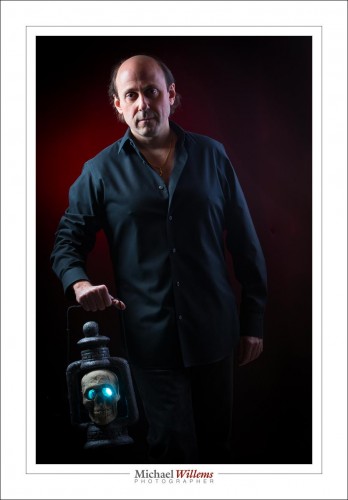For the making of this kind of wizard, I need another type of wizard.
Namely, Pocketwizards. This is manual flash, fired by Pocketwizard radio triggers. I used a key light (camera left), a fill and rim light (right), a background light (gelled, background left), and a fourth flash, a gelled flash behind the skull. Four flashes, fired by five Pocketwizards.
“I don’t have that kind of money, to buy five radio triggers”, I hear some of you say. “I am going to just use wireless TTL, my camera’s built-in system (Canon e-TTL, Ninon i-TTL/CLS, etc)”.
Let’s have a look. 5 Triggers can cost up to $500. Wireless TTL is included in your Nikon or Canon (or Sony, etc) system, so costs nothing. Easy decision. Of course TTL is cheaper. Right?
All I need for the cheap “TTL solution” is four flashes by Canon or Nikon. Or, if I have a pro camera that does not contain a pop-up flash, five flashes by Canon or Nikon. One needs to be a 580EX/600EX (Canon) or SB800/900/910 (Nikon). Total cost? Between $1500 and $2500. Peanuts.
And for the expensive Pocketwizard solution, I need five expensive triggers; say $500. And then five “any type” flashes: any brand, any type as long as they use a standard hotshoe or an x-type connector, and they can fire manually at a power level of my choosing, and I can disable any auto-switchoff timeout. These flashes can be as little as under $100. And I only need four at most. Say, $400, then. And perhaps cables from Flashzebra dot com, another $100. So the total cost can be as low as $1000.
Wait. The cheap solution is $1500-$2000, and the expensive solution costs $1000? Perhaps things aren’t so simple after all. Just sayin’.
Yes, using radio triggers can be cheaper because you do not need your brand’s TTL flashes. Whatever brand you use, the remote flashes can be new or old and can be made by Canon, Nikon, Vivitar, Olympus, one of the Chinese, Taiwanese, or Korean clone makers: don’t care. And that can save you a lot of money.
____
Check out my e-books on http://learning.photography/collections/books and learn everything I know. Taught in a logical fashion, these extensive e-books (PDFs with 100-200 pages each) will help you get up to scratch quickly with all the latest techniques. And when combined with a few hours’ private coaching, in person or via Google Hangouts, you have no idea of the places you’ll go. You’ll be a pro!


I like like this photo, Michael! What modifier did you use for the fill/rim light? I need more speedlights.
I used softboxes, Lisa. On both sides. Positioned ever so slightly behind the subject. Umbrellas would have done too, but not as well, since they would have thrown light all through the room.
Before someone says “Ahh, but I can save money if I get the cheap radio triggers off eBay instead of PocketWizards….”
PocketWizard is THE standard for these things – has been for decades – and with good reason. Pretty much all the accessories, spare parts, etc. you’ll find for radio triggers is designed around the PocketWizard system, from the simplest cable adapters right up to the add-in radio for Sekonic professional light meters. The junk you buy from the numbered Hong Kong warehouse will probably work, for a little while, with the other stuff from the same box. But it won’t work with last year’s version, or next year’s, or with anyone else’s stuff.
If PocketWizard gear is out of your budget for now, just stick with optical slave cells until that changes. (The optical sync slave built into my $75 Yongnuo YN560-II speedlights, for example, is perfectly reliable even in full sunlight at 20 metres range.)
And if you do that, don’t use TTL, remember. The TTL pre-flash will set off the flashes prematurely.